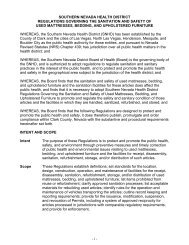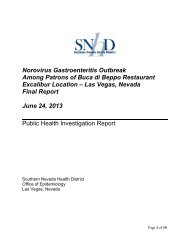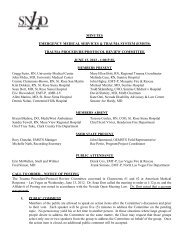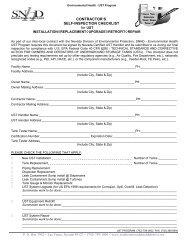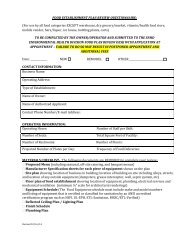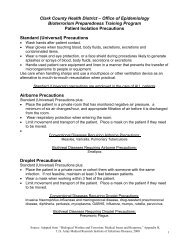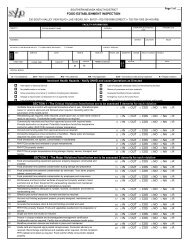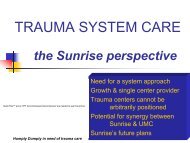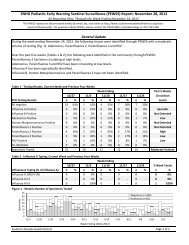Current Trauma Status Report - Southern Nevada Health District
Current Trauma Status Report - Southern Nevada Health District
Current Trauma Status Report - Southern Nevada Health District
You also want an ePaper? Increase the reach of your titles
YUMPU automatically turns print PDFs into web optimized ePapers that Google loves.
Survey of Other Freestanding <strong>Trauma</strong> Centers<br />
The freestanding trauma center at UMC is one of only a few freestanding trauma centers in the nation.<br />
For the purpose of learning about the experiences of other freestanding trauma centers The Abaris<br />
Group contacted the following:<br />
• Elvis Presley Memorial <strong>Trauma</strong> Center at The Med in Memphis, Tennessee<br />
• R Adams Cowley Shock <strong>Trauma</strong> Center at the University of Maryland in Baltimore, Maryland<br />
• Ryder <strong>Trauma</strong> Center at the University of Miami/Jackson Memorial Medical Center in Miami,<br />
Florida<br />
• Martin Luther King/Drew Medical Center in Los Angeles, CA<br />
Of the four, the first two agreed to be interviewed. Their responses are presented below.<br />
Survey of Other Freestanding <strong>Trauma</strong> Centers<br />
<strong>Trauma</strong> Center<br />
Elvis Presley Memorial <strong>Trauma</strong> Center<br />
R Adams Cowley Shock <strong>Trauma</strong> Center<br />
at The Med<br />
Location Memphis, TN Baltimore, MD<br />
Designation Level Level I Level I+<br />
On-call coverage in excess of ACS standards for Level I<br />
Affiliation University of Tennessee University of Maryland<br />
Configuration of Center Adjacent to ED but separate and with own ICU Stand alone<br />
<strong>Trauma</strong> System<br />
State system has 12 trauma centers; six Level I centers; two<br />
Level II centers; and four Level III centers<br />
State system has 9 trauma centers: the Shock <strong>Trauma</strong><br />
Center, which is known as a Primary Adult Resource Center<br />
(PARC); one Level I center; two Level II centers; and five<br />
Level III centers<br />
Catchment Area<br />
Memphis also has a Level II, but this is the only Level I<br />
center in West Tennessee; the catchment area has a radius<br />
of 175 miles, and transfers come from other states including<br />
Arkansas and Mississippi<br />
Primary catchment area is approximately 50 miles, but the<br />
trauma center takes patients from farther if they think the<br />
patient can make it; patients also are transported from<br />
Pennsylvania, Delaware, Virginia, and West Virginia; and<br />
transfers arrive from all over<br />
Governance Tennessee EMS Division Maryland Institute for EMS Systems (MIEMSS)<br />
Works Well Governance structure; also, true dedication to trauma Good relationship with EMS at all levels; also, utilization of<br />
state medivac helicopters run by police with paramedics on<br />
board - they transport the whole spectrum of patients, and<br />
the paramedics are truly active<br />
Presents Challenge<br />
Diversion<br />
The way transfers are received, i.e. dumping - need to <strong>Trauma</strong> patients receive care from a wide spectrum of<br />
provide education on what constitutes a Level I patient providers, from BLS volunteers to full-time ALS paramedics,<br />
so it is a challenge to maintain the same level of quality and<br />
monitoring at all levels<br />
Only when all ORs are full, which is very rare; probably<br />
occurred for 5 hours or less in 2003 - a summer day would<br />
be when it might happen<br />
Try not to go on diversion; the "trauma line" will sometimes<br />
ask for details of a patient from the field and potentially<br />
refer the patient to the Level I center<br />
Capacity<br />
Resuscitation Bays 5 10<br />
ORs<br />
4 on the weekend; overflow available to 8-12 elective surgery<br />
6<br />
ORs on weekdays<br />
ICU Beds<br />
23 beds in the trauma-only ICU: 8 neuro and 8 surgery<br />
intensive care beds, plus a trauma stepdown unit of 7 beds<br />
24 critical care beds and 24 intermediate care beds (which<br />
can still handle ventilators)<br />
in which 4 can by ICU<br />
Hospital beds (licensed) 330 36 acute care beds; 118 total beds at the trauma center; 650<br />
beds at University Hospital, where patients are occasionally<br />
sent<br />
Annual <strong>Trauma</strong> Volume, 2003<br />
<strong>Trauma</strong> Arrivals 20,000 6,000<br />
Transfers Portion 1,500 (by helicopter) 1,000<br />
<strong>Trauma</strong> Activations 1,874 Level I activations 6,000<br />
<strong>Trauma</strong> Inpatient Admissions 4,500 (the Level I activations and approximately 2,600 6,000 (all are admitted, and about half stay over 24 hours)<br />
Level II and III cases)<br />
Sources: Interviews by The Abaris Group; Tennessee trauma system information from state web site<br />
Page 65



